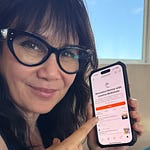Is it ok to wear summer clothes in winter?
Is it ok to drink milk past the sell by date?
Is it ok for older workers to be pushed out once they reach a certain age?
I started asking myself that last question when I noticed that I still have a healthy poinsettia plant in my office and yet it’s the end of March. Isn’t it time to get rid of it since I’m no longer in the winter holiday season? I mean after all, it’s time to bring in some spring flowers, right?
Well, no. It’s wrong. The plant is healthy, in fact it’s sorta thriving, and it brightens up the space and cleans the air. It also symbolically represents good cheer and success. I’ve also heard that poinsettia sap can relieve pain although I’d need to do a lot more research on how to make that happen. All this to say, I’m not getting rid of my plant even though it’s “out of season.”
Which is why I strongly challenge anyone who says “it’s time” for someone to move on based solely on their age.
It is ok to wear summer clothes in winter. Go crazy.
It’s also ok to drink milk past the sell by date. Just give it a sniff first.
It is not ok for older workers to be pushed out for any reason. That’s ageism.
WHAT IS AGEISM?
Ageism is a form of discrimination or prejudice against individuals based on their age. While ageism can affect individuals of all ages, it often targets older adults, perpetuating harmful misconceptions about their capabilities and contributions.
Despite strides toward inclusivity, ageism remains a prevalent issue in many workplaces especially in the entertainment industry. I’ve heard from so many people how there is a lack of opportunities for older artists, crafts people and executives.
Moreover, the experience of ageism often intertwines with feelings of grief, as older workers may grapple with a sense of loss due to being marginalized or undervalued in their professional environments.
PREVALENCE OF AGEISM IN THE WORKPLACE
Ageism in the workplace is alarmingly prevalent, with numerous studies shedding light on its pervasive nature and detrimental impact.
According to research cited by Medical News Today, ageism affects a significant portion of older workers, with approximately 64% reporting experiences of age discrimination (Medical News Today).
A study conducted by the AARP found that nearly 2 in 3 workers aged 45 and older have witnessed or experienced age discrimination in the workplace. These statistics underscore the widespread nature of ageism and its profound implications for older adults seeking to remain active and engaged in the workforce.
In addition to facing barriers during the hiring process, older workers often encounter challenges related to career advancement and retention. Data from Indeed's research on ageism in the workplace reveals that older employees are frequently overlooked for promotions in favor of younger colleagues, contributing to feelings of marginalization and frustration (Indeed). Furthermore, systemic ageism can perpetuate inequalities within organizations, limiting opportunities for older workers to contribute their skills and expertise fully.
RECOGNIZING AGEISM IN THE WORKPLACE
Signs of ageism in the workplace may include being passed over for promotions in favor of younger colleagues, receiving disparaging remarks about one's age or abilities, or being excluded from decision-making processes.
Additionally, ageism can manifest in more covert ways, such as through microaggressions or systemic biases embedded within organizational structures (Indeed).
THREE TYPES OF AGEISM
It’s important to know that ageism manifests in various forms, each with its own unique implications. The three primary types of ageism include:
Explicit Ageism: This type of ageism involves overt acts of discrimination or prejudice based on age. Examples may include refusing to hire older workers or making derogatory comments about their age or abilities.
Implicit Ageism: Implicit ageism is more subtle and may involve unconscious biases or stereotypes about older adults. It can influence decision-making processes, leading to disparities in opportunities or treatment based on age.
Systemic Ageism: Systemic ageism refers to age-related biases that are ingrained within societal structures or institutional practices. This form of ageism can perpetuate inequalities and limit the opportunities available to older workers.
EXPERIENCING AGEISM IS A SOURCE OF GRIEF
The experience of ageism in the workplace often intersects with the concept of disenfranchised grief, amplifying its impact on older workers.
Disenfranchised grief refers to feelings of loss that are not openly acknowledged or validated by society (AARP). For older adults facing ageism, the sense of loss may stem from being pushed out of their roles, disregarded or disrespected by colleagues, or relegated to less challenging responsibilities.
Research from the National Center for Biotechnology Information (NCBI) highlights the emotional toll of ageism in the workplace, noting that older adults may experience a range of negative emotions, including sadness, anger, and frustration.
These feelings of grief and loss can be compounded by the lack of recognition or support from peers and employers, exacerbating the psychological impact of ageism.
WHAT TO DO WHEN YOU FACE AGEISM IN THE WORKPLACE
There isn’t an easy answer, but there are proactive steps one can take to assert their rights and address discriminatory behaviors. Here are six ideas.
Educate Yourself: Familiarize yourself with age discrimination laws and company policies related to equal employment opportunities. Understanding your rights and protections empowers you to advocate for fair treatment in the workplace. This piece from the AARP is a good place to start.
Document Incidents: Keep detailed records of any instances of age discrimination or bias that you encounter. Note dates, times, and specific details of the incidents, as well as any witnesses who may have observed the behavior. This documentation can be valuable evidence if you choose to pursue a formal complaint or legal action.
Seek Support: Reach out to trusted colleagues, mentors, or HR representatives for support and guidance. Discuss your concerns and explore potential solutions for addressing age-related bias in the workplace. Building a support network can provide reassurance and validation during challenging times. In addition, consider getting support from a grief specialist who has an expertise with dis-enfranchised grief. It’s important to have your loss be acknowledged, validated and mourned.
Address Concerns Directly: If you feel comfortable, consider addressing ageist remarks or behaviors directly with the individuals involved. Communicate assertively and professionally, expressing how their actions or comments have affected you and advocating for respectful treatment. This approach is not for everyone or for every environment.
Utilize Internal Resources: Take advantage of internal resources, such as employee assistance programs or diversity and inclusion initiatives, to seek assistance and support. These resources may offer counseling services, conflict resolution assistance, or educational workshops on combating bias in the workplace.
Consider External Support: If internal avenues for addressing ageism are ineffective or unavailable, explore external resources such as legal counsel or advocacy organizations specializing in age discrimination. These entities can provide guidance on your rights and options for recourse under applicable laws.
By taking proactive measures and advocating for yourself in the face of ageism, you can assert your value and contribute to fostering a more inclusive and respectful work environment.
BOTTOM LINE
The attitude and acceptance that it’s ok to dismiss, dump, neglect or reject objects, plants or people based on a mistaken belief that they’re no longer “good” or “in season” is ridiculous. Our society’s collective obsession with youth and what’s new causes great harm to humanity, the environment and community.
Through educating ourselves, seeking support, and taking proactive steps to address age-related bias, we can foster a more inclusive and respectful work environment. I believe that together we can create a more equitable and inclusive workplace for everyone, regardless of age.
JOURNAL PROMPTS
Here are five journal prompts to help you deepen your understanding of ageism in the workplace and its intersection with disenfranchised grief:
1. Reflect on a personal experience or observation of ageism in the workplace. How did it impact the individuals involved, and what emotions did it evoke for you? Consider how the concepts of disenfranchised grief may apply in this situation.
2. Explore your own attitudes and beliefs about aging and older adults. Have you ever held stereotypes or biases about older workers? How might these attitudes influence your interactions with colleagues of different ages in the workplace?
3. Imagine yourself in the position of an older worker facing ageism. How would you navigate the challenges and emotions associated with being marginalized or undervalued in the workplace? Consider practical strategies for addressing ageism and advocating for yourself in this scenario.
4. Consider the role of organizational culture and leadership in addressing ageism in the workplace. How can leaders promote inclusivity and combat age-related biases within their teams or organizations? What policies or practices could be implemented to create a more supportive environment for workers of all ages?
5. Reflect on the broader societal implications of ageism and its impact on individuals and communities. How does ageism intersect with other forms of discrimination, such as racism, sexism, or ableism? What steps can society as a whole take to challenge ageism and promote intergenerational understanding and respect?
P.S. Check out this interview I did with
where we discuss everything from self worth to corporate toxicity to pitching to NETFLIX.🙌🏾 Questions? Would you like additional support in accessing resilience? I offer private coaching sessions as well as in-person and virtual group work. Reach out directly here to set up a complimentary consultation.
If you’re resonating with what you’re reading, please consider subscribing. What’s that mean?
🙌🏾 You’ll receive regular emails (with lots of heart and a bit of humor) that share a tool or insight from my coaching practice.
🙌🏾 Typically the blog and blogcast will have a question at the end to provoke thought that supports you in your growth.
🙌🏾 Updates on offerings, free stuff, recommendations, referrals.
My blog aims to help people achieve their ambitious goals, their moonshot if you will. 😃 Oftentimes, though, we neglect an essential aspect of pursuing our dreams: the inevitable missteps, obstacles, and failures that come our way. Failing to acknowledge and process these losses properly can lead to imposter syndrome, burnout, low self-esteem, confusion, and even result in completely abandoning our dreams. 😟 That's why I strongly advocate for embracing grief awareness (along with other tools like values identification, knowing your why, sharpening executive function, habit forming, and more.) By doing so, we can effectively navigate challenges, regain motivation, and hit our moonshots. ✌🏾️ If you know someone who could benefit, please share this newsletter or recommend me to them. 🙏















Share this post